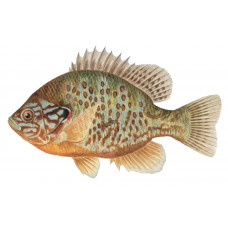Latin name
Lepomis gibbosus
Other names
No information
Identification
Each species has coarse scales and two united dorsal fins, the first of which is strongly spined. The anal fins have three or more spines, and the tail is usually broad. The black bass belongs to the genus Micropterus. It has a more elongated body than the other centrarchids and includes the largest and best known member of the family - the largemouth bass. Sgarius belongs to the genus Pomoxis. It has a longer anal fin, usually equal in length at the base to the dorsal fin, than other centrarchids and is capable of greater growth than most sunfishes. There are two species of srarchids, but ichthyologists sometimes lump together a smaller, similar species, the flyer (Centrarchus macropterus). Popularly, it is usually referred to as a sunfish. The largest group of centrarchids are the true sunfishes. Most species are small and of little interest to anglers, although they are important in their respective habitats as food for larger predators and as food for themselves. True sunfishes do not include the dwarf sunfishes of the family Elassomatidae. The most common and best known sunfish is the bluegill. It and many other sunfish species are colloquially called bream. Other popular sunfish species include green, pumpkinseed, redbreast, redear, warmouth, and rock bass. In some areas, anglers may find sunfish such as Sacramento Perch (Archoplites interruptus), Roanoke Bass, Orangespotted Sunfish (Lepomis humilis), Mud Sunfish, and Spotted Sunfish (Lepomis punctatus).
Distribution
Sunfish are tolerant of a variety of environments and have proven to be very adaptable. They have been widely introduced, sometimes intentionally and sometimes accidentally, to other regions of North America, as well as to Europe and Africa. In some places they are kept in balance by fishing and natural predation, but in others they become overpopulated, resulting in stunted growth.
Habitat
The centrarchids number about 30 strictly freshwater species of North America and include three generalized subclasses: black bass, crappie, and true sunfish. All are warm-water species with similar or overlapping habitats. The shallow-water habitat of true sunfish allows them to be fished inshore, generally making them an important warm-water species for non-boating anglers.
Size
No information
Life history and Behavior
Almost all species nest, with nests built by males, who also briefly guard the nests and young.
Food and feeding habits
All species are carnivorous, with larger ones preying on small fish.
Reproduction
No information
| Classification | |
| Phylum | Chordata |
| Class | Actinopterygii |
| Squad | Perciformes |
| Family | Centrarchidae |
| Genus | Lepomis |
| Species | L. gibbosus |
| Features | |
| Conservation status | Least Concern |
| Habitat | Pelagic |
| Life span, years | No information |
| Maximum body weight, kg | 0.68 |
| Maximum length, cm | 28 |
| Sailing speed, m/s | No information |
| Threat to people | No information |
| Way of eating | Bentophage |




